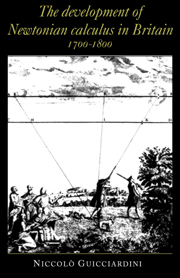Book contents
- Frontmatter
- Contents
- Introduction
- OVERTURE: NEWTON'S PUBLISHED WORK ON THE CALCULUS OF FLUXIONS
- PART I THE EARLY PERIOD
- 1 THE DIFFUSION OF THE CALCULUS (1700–30)
- 2 DEVELOPMENTS IN THE CALCULUS OF FLUXIONS (1714–33)
- 3 THE CONTROVERSY ON THE FOUNDATIONS OF THE CALCULUS (1734–42)
- PART II THE MIDDLE PERIOD
- PART III THE REFORM
- CONCLUSION
- APPENDIX A TABLES OF CONTENTS OF FLUXIONARY TEXTBOOKS
- APPENDIX B PRICE LIST OF MATHEMATICAL BOOKS PRINTED FOR JOHN NOURSE
- APPENDIX C CHAIRS IN THE UNIVERSITIES
- APPENDIX D MILITARY ACADEMIES
- APPENDIX E SUBJECT INDEX OF PRIMARY LITERATURE
- APPENDIX F MANUSCRIPT SOURCES
- Notes
- Bibliography
- Index
3 - THE CONTROVERSY ON THE FOUNDATIONS OF THE CALCULUS (1734–42)
from PART I - THE EARLY PERIOD
Published online by Cambridge University Press: 14 September 2009
- Frontmatter
- Contents
- Introduction
- OVERTURE: NEWTON'S PUBLISHED WORK ON THE CALCULUS OF FLUXIONS
- PART I THE EARLY PERIOD
- 1 THE DIFFUSION OF THE CALCULUS (1700–30)
- 2 DEVELOPMENTS IN THE CALCULUS OF FLUXIONS (1714–33)
- 3 THE CONTROVERSY ON THE FOUNDATIONS OF THE CALCULUS (1734–42)
- PART II THE MIDDLE PERIOD
- PART III THE REFORM
- CONCLUSION
- APPENDIX A TABLES OF CONTENTS OF FLUXIONARY TEXTBOOKS
- APPENDIX B PRICE LIST OF MATHEMATICAL BOOKS PRINTED FOR JOHN NOURSE
- APPENDIX C CHAIRS IN THE UNIVERSITIES
- APPENDIX D MILITARY ACADEMIES
- APPENDIX E SUBJECT INDEX OF PRIMARY LITERATURE
- APPENDIX F MANUSCRIPT SOURCES
- Notes
- Bibliography
- Index
Summary
the problem of foundations did not exist in the eighteenth century as we understand it nowadays. Mathematicians were more occupied with defining the ‘principles’ of the calculus. They were concerned with the ontological status of the objects of the calculus and with the correctness of the methods of the calculus according to the standards of Aristotelian logic. In 1734 these issues were raised by Berkeley in The Analyst (1734). His criticisms were particularly devastating in Britain since the terminology of the fluxionists was very loose, being a mixture of Newtonian and Leibnizian ideas. A controversy between Berkeley and some defenders of Newton occupied the years 1734–5. Later the debate divided the fluxionists themselves. These years of debate were of great importance since the British were compelled to reread Newton in order to remove from his calculus the flaws indicated by Berkeley. The great champion of this process of reinterpretation was Maclaurin. After his Treatise (1742) the calculus of fluxions solidified into a theory based on an ‘axiomatization’ of the basic properties of motion and velocity in which geometric limit processes were prominent.
Berkeley's criticisms of the calculus
The most famous aspect of the history of eighteenth-century British calculus is undoubtedly the controversy originated by The Analyst (1734). As is well known, George Berkeley (1685–1753) criticized in this short pamphlet the foundations of the fluxional and the differential calculus.
- Type
- Chapter
- Information
- Publisher: Cambridge University PressPrint publication year: 1989
- 1
- Cited by



